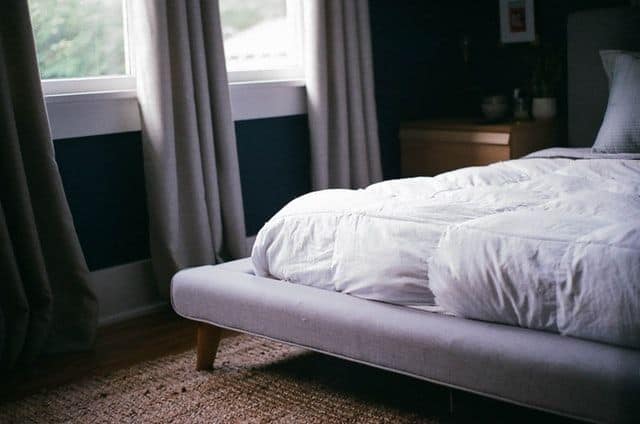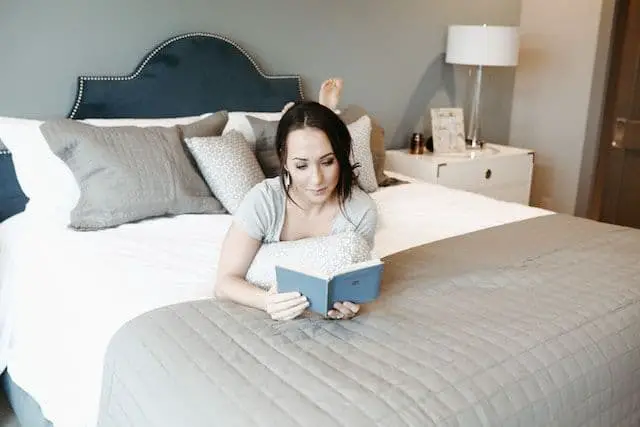Mattress shopping is a challenging task.
When trying to narrow down the choices, you must consider your sleeping style. If you sleep on your side, you might need a different type of mattress than someone who sleeps on their back or stomach.
Many side sleepers think they need a firm, unyielding mattress. But is this true?
Do side sleepers need a firm mattress? The short answer is maybe. Some side sleepers need a mattress on the firmer side, while others need softer mattresses.

The rest of this article will discuss the types of mattresses that work for different side sleepers. If you’re a side sleeper looking to buy a new mattress, read on.
Why Does My Sleeping Position Matter When Choosing a Mattress?
Different sleeping positions will have you placing your weight in different areas of your body.
For example, a back sleeper will exert a different amount of pressure on a mattress than a side sleeper.

Understanding Side Sleepers
Several sleep surveys and researchers have found that a majority of Americans (over 70%) are side sleepers.
So before getting into the nitty-gritty of which mattress fits you perfectly, it’s helpful to take some time to understand side sleepers and their unique sleeping needs.
As the name suggests, a side sleeper is someone who sleeps on their side. There are various types of side sleeping positions, including:
- The fetal position: this is the most popular side sleeping position, where the sleeper curls up with their knees and chin close to their chest, often with their arms hugging their knees.
- The thinker: The thinker sleeps like the fetal sleeper, but tucks their hand under their chin, so they resemble Michelangelo’s thinker sculpture.
- The log position: The log sleeper sleeps on the side with their legs stretched out and their arms tucked in close to their body.
- The yearner: The yearner sleeps like the log sleeper, but stretches their arms out from their body; almost like they’re reaching yearningly for something in the distance!
- The sprinter: like the fetal sleeper, the sprinter sleeps curled up but has one leg stretched out, and one leg tucked close to the body. The sprinter is not an ideal side sleeping position as it can cause a misalignment of the pelvis.

Each type of side sleeping position impacts the body in different ways. However, most sleep experts agree that side sleeping is good for the body as it supports the natural curvature of the spine and allows your body to remain in alignment through your sleep.
There are some things to keep in mind if you’re a side sleeper.
Side sleeping can cause wrinkles on the face, as your face tends to be pressed up against your pillow all night.
Fetal sleepers who tightly curl up may put extra pressure on their back and shoulders while all side sleepers can put extra pressure on their arms, resulting in arm numbness when they wake up.
Fortunately, most of these problems can be solved with a good mattress.
How Firm Is Too Firm?
No side sleeper needs an extremely firm mattress.
This is because side sleepers have certain pressure points, which are the parts of your body that receive the most weight.
Side sleepers’ pressure points include the ankles, the hips, the shoulders, and the head. A mattress that is too firm will push against your pressure points, causing pain and discomfort throughout the night. Most side sleepers, therefore, need mattresses of medium firmness.
The Best Type of Mattress for Side Sleepers

When deciding on the type of mattress that works best for you, consider what parts of your body touch the mattress and how much support your body needs.
Side sleepers need a mattress firm enough to support the curved parts of the body, especially your neck and your waist.
At the same time, side sleepers need a mattress that is soft enough to give way to the shape of the body. Mattresses that are either too firm or too soft will cause your body to maintain an unnatural posture while you’re sleeping and, in the long run, can cause misalignment and spinal issues.
So, most side sleepers should look for a mattress that falls between firm and soft. The most important thing to consider when gauging mattress firmness is the type of material that the mattress is made of.
Mattresses that are best suited for side sleepers can be made with memory foam, latex or a combination of innerspring coils and memory foam or gel.
Memory Foam Mattresses
Memory foam mattresses are made of viscoelastic, a material that is designed to absorb and respond to pressure. If you sleep on a memory foam mattress, the memory foam will sink to contour around your body and then rise back into place once you get up.
Memory foam mattresses are great for side sleepers as they allow your pressure points, like your shoulder and hips to sink into the mattress while still providing your spine with support.
Quality memory foam mattresses will last 5-6 years but will then begin to lose their contouring properties.
Memory foam mattresses are great if you’re sharing a bed, as they have very little motion transfer – if you get up for a midnight snack, your motion won’t transfer across the mattress and disturb your partner.
However, if you tend to feel hot while you sleep, a memory foam mattress may not be the best way to go. Memory foam absorbs body heat and can, therefore, make you hotter.
Hybrid Mattresses
Hybrid mattresses may be a better option if you sleep hot. Hybrid mattresses combine features of the innerspring and memory foam mattresses together to create a mattress that contours to your body shape, but does not trap heat.
Because hybrid mattresses are topped with memory foam, they adapt to the shape of your body, relieving pressure on your shoulders, hips, and spine.
Underneath the memory foam, however, are wound coils that make the mattress firmer than a typical memory foam one. As a result, hybrid mattresses last longer; about 6-7 years. They don’t absorb motion as easily and tend to be more expensive, but are good options for side sleepers.
Latex Mattresses
Another option for side sleepers who sleep hot is the latex mattress, made with sap from latex producing trees.
As it’s a naturally derived material, latex does not absorb as much heat as memory foam does. Latex mattresses are great for side sleepers as they absorb pressure without changing their shape, similar to a memory foam mattress.
When they have similar properties, why choose a more expensive latex mattress over a memory foam one?
First of all, organic latex mattresses are better for side sleepers who have allergies as they contain and trap fewer allergens than other mattresses.
They are also eco-friendly and last longer than other mattresses – you won’t have to change your latex mattress for at least seven years. They also absorb motion transfer, ensuring you don’t bother your bed mate.
Choosing A Mattress Firmness Based On Your Weight

While latex, hybrid, and memory foam mattresses are generally the best mattress for side sleepers, you should also choose the firmness of your mattress based on your weight.
130 Pounds or Fewer?
Memory foam mattresses, which are softer than their other counterparts, are best for lighter side sleepers who weigh 130 or fewer pounds.
This is because they don’t place to much pressure on their mattress, and their pressure points are less likely to sink into the mattress.
These side sleepers do not need a firm mattress. In fact, a firmer mattress will be uncomfortable as it will push back against the sleeper.
130-230 Pounds?
These side sleepers need a medium-firm mattress like a latex mattress or even a hybrid one. People with an average weight need a mattress that will comfortably absorb pressure points while maintaining the balance and alignment of the rest of the body.
More than 230 pounds?
A side sleeper who is more than 230 pounds needs a firmer mattress.
A mattress that is too soft will simply absorb the weight of the sleeper, causing them to sink too deep into the mattress and prevent the spine from maintaining the correct alignment.
A firmer mattress will support the sleeper’s weight but gently contour around the pressure points.
If you’re more than 230 pounds, a hybrid mattress will serve you best; look out for a mattress that combines helix coils with a layer of memory foam. The memory foam will absorb your weight, but the coils will stop you from sinking in too deep.
Best Mattresses For Side Sleepers With Body Pains

As well as your weight, you need to consider other factors when deciding on the firmness of your mattress. Do you, for instance, find yourself with excruciating shoulder, hip, or back pain when you wake up?
It may be because, as a side sleeper, these areas tend to have the most pressure on them. As you sleep, your shoulders, hips, and back may become misaligned.
Select the right mattress to help prevent and alleviate the pains.
Neck & Shoulder Pains

The most common pains that side sleepers suffer from are neck and shoulder pains.
This is because, as you sleep, tendons (connective tissues) rub against your shoulder blades, causing friction and pain.
If you want to stop this from happening, your mattress needs to be soft enough to relieve the pressure on the shoulder so that tendons and shoulder blades are not forced together.
A memory foam mattress would work best, as it will adapt to your unique shoulder and neck placement. Getting a memory foam pillow will also help as it will adapt itself to support your neck in alignment with your shoulder.
Hip Pain
Hip pain is caused because of inflammation in the hip joints, or because the cartilage which protects the hip bone has broken down, creating more friction between the bones. Hip pain may be caused by a variety of conditions, from arthritis to sprains.
To stop your pain from getting worse as you slumber, invest in a gel-infused memory foam mattress. Gel-infused mattresses contain gel microbeads, which will help the mattress retain its shape even as the memory foam adapts to fit your shape.
As a result, you enjoy a mattress that is soft enough to cushion your hips, but firm enough so that the rest of your body doesn’t sink!
Back Pain

For many years, doctors and sleep experts have recommended that sleepers with lower and upper back pain should be sleeping on a very firm – almost hard – mattress.
However, recent studies have found that a mattress that is too firm can only worsen your back pain. Instead, look for a medium-firm mattress to support your back and spine through the night.
A hybrid mattress with an innerspring base and a memory foam top is ideal as the memory foam will contour the body, and the springs will stop your mattress from sagging too much.
Getting the right mattress will definitely help alleviate the pain you feel as you wake up. Be sure to change your mattress every few years as mattresses lose their shape over time, which eventually puts pressure on your muscles.
Side Sleeping When You’re Pregnant

Side sleeping is the most comfortable sleeping position for many, but it’s especially recommended if you’re pregnant.
Sleeping on the side – or SOS as the doctors call it – is better. It’s the best way to deal with the discomfort that pregnancy brings like heartburn, backache, and shortness of breath.
Sleeping on your left side is ideal because it helps blood circulation, ensuring that the growing fetus receives enough nutrients and oxygen.
This article is owned by Sleeping Report and was first published on December 27, 2019
If you’re pregnant, then getting the right mattress is even more essential; you need enough sleep to protect both you and your baby’s health.
The most comfortable mattress for a pregnant woman is a medium-firm one. Sleep experts suggest high-quality memory foam or latex mattresses, as they’ll adapt as the shape of your body changes.
Mattresses with a medium firmness will also make getting up off the bed easier as many pregnant women are prone to do through the night. They’ll also reduce motion transfer, so your partner is not disturbed as you get up.
Pregnancy can also cause rapid temperature changes in your body; many pregnant women sleep very hot. Getting a gel foam mattress can help; the gel beads do not trap heat, helping the sleeper stay cool. Gel foam mattresses offer similar support to memory foam ones but tend to be more expensive.
Mattresses To Avoid If You’re A Side Sleeper

Now that you have a wealth of information about which mattress firmness is best for a side sleeper, it’s worth taking a moment to consider which mattresses you should absolutely avoid.
This article is owned by Sleeping Report and was first published on December 27, 2019
Innerspring mattresses with spring coils should be well out of your radar – they are hard, unyielding, and will push back against your body, causing discomfort to your pressure points.
You should also stay clear of air and waterbeds as their firmness tends to fluctuate throughout the night, which will make your alignment inconsistent. Waterbeds, in particular, will not give the body the support it needs.
Other considerations when mattress shopping
If this guide has helped you understand which mattress firmness you need, it’s time for the next stage: going mattress shopping!
As well as the firmness of the mattress, here are some other things you need to consider:
- Do you want a generic or branded mattress? While generic mattresses are cheaper, branded mattresses are made with higher quality materials.
- Is your mattress under warranty? Make sure that your mattress comes with a warranty. Mattress firmness can change over time, but if it begins sagging in the first year, then you should get it replaced under warranty.
- Does your mattress offer a trial period? If you’re still debating on which kind of mattress would work best for you, look for brands that offer a 100 day trial period. Try mattresses of varying firmness and see which one your body responds best to.
Final Thoughts
This guide explores a variety of different considerations you need to keep in mind about your mattress if you’re a side sleeper.
Most side sleepers find that medium-firm mattresses work best, but heavier sleepers may prefer a more firm mattress.
No side sleeper should get a mattress that is too soft, as this will throw your spine into misalignment.
However, listen to what your body is telling you – if you’re waking up with aches and pains, it may be a sign that your mattress is not working for you.
Take advantage of trial periods and explore different firmness of mattresses to see which one you’re most comfortable with.
SleepingReport.com copyright article was updated on ..
Investing the time and effort in finding the right mattress is important and rewarding; you’ll sleep easier and wake up feeling well-rested and ready to take on each day!

